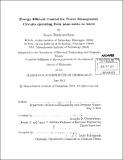Energy efficient control for power management circuits operating from nano-watts to watts
Author(s)
Bandyopadhyay, Saurav
DownloadFull printable version (25.26Mb)
Other Contributors
Massachusetts Institute of Technology. Department of Electrical Engineering and Computer Science.
Advisor
Anantha P. Chandrakasan.
Terms of use
Metadata
Show full item recordAbstract
Energy efficiency and form factor are the key driving forces in today's power electronics. All power delivery circuits, irrespective of the magnitude of power, basically consists of power trains, gate drivers and control circuits. Although the control circuits are primarily required for regulation, these circuits can play a crucial role in achieving high efficiency and/or minimizing overall system form-factor. In this thesis, power converter circuits, spanning a wide operating range- from nano-watts to watts, are presented while highlighting techniques for using digital control circuits not just for regulation but also to achieve high system efficiency and smaller system form-factor. The first part of the thesis presents a power management unit of an autonomous wireless sensor that sustains itself by harvesting energy from the endo-cochlear potential (EP), the 70-100mV electrochemical potential inside the mammalian inner ear. Due to the anatomical constraints, the total extractable power from the EP is limited to 1.1-6.3nW. A low switching frequency boost converter is employed to increase the input voltage to a higher voltage usable by CMOS circuits in the sensor. Ultra-low power digital control circuits with timers help keep the quiescent power of the power management unit down to 544pW. Further, a charge-pump is used to implement leakage reduction techniques in the sensor. This work demonstrates how digital low power control circuit design can help improve converter efficiency and ensure system sustainability. All circuits have been implemented on a 0.18[mu]m CMOS process. The second part of the thesis discusses an energy harvesting architecture that combines energy from multiple energy harvesting sources- photovoltaic, thermoelectric and piezoelectric sources. Digital control circuits that configure the power trains to new efficient system architectures with maximum power point tracking are presented, while using a single inductor to combine energy from the aforementioned energy sources all at the same time. A dual-path architecture for energy harvesting systems is proposed. This provides a peak efficiency improvement of 11-13% over the traditional two stage approach. The system can handle input voltages from 20mV to 5V and is also capable of extracting maximum power from individual harvesters all at the same time utilizing a single inductor. A proposed completely digital timebased power monitor is used for achieving maximum power point tracking for the photovoltaic harvester. This has a peak tracking efficiency of 96%. The peak efficiencies achieved with inductor sharing are 83%, 58% and 79% for photovoltaic boost, thermoelectric boost and piezoelectric buck-boost converters respectively. The switch matrix and the control circuits are implemented on a 0.35pm CMOS process. This part of the thesis highlights how digital control circuits can help reconfigure power converter architectures for improving efficiency and reducing form-factors. The last part of the thesis deals with a power management system for an offline 22W LED driver. In order to reduce the system form factor, Gallium Nitride (GaN) transistors capable of high frequency switching have been utilized with a Quasi-Resonant Inverted Buck architecture. A burst mode digital controller has been used to perform dimming control and power factor correction (PFC) for the LED driver. The custom controller and driver IC was implemented in a 0.35[mu]m CMOS process. The LED driver achieves a peak efficiency of 90.6% and a 0.96 power factor. Due to the high power level of the driver, the digital controller is primarily used for regulation purposes in this system, although the digital nature of the controller helps remove the passives that would be normally present in analog controllers. In this thesis, apart from regulation, control circuit enabled techniques have been used to improve efficiency and reduce system form factor. Low power design and control for reconfigurable power train architectures help improve the overall power converter efficiency. Digital control circuits have been used to reduce the form factor by enabling inductor sharing in a system with multiple power converters or by removing the compensator passives.
Description
Thesis (Ph. D.)--Massachusetts Institute of Technology, Dept. of Electrical Engineering and Computer Science, 2013. Cataloged from PDF version of thesis. Includes bibliographical references (p. 163-172).
Date issued
2013Department
Massachusetts Institute of Technology. Department of Electrical Engineering and Computer SciencePublisher
Massachusetts Institute of Technology
Keywords
Electrical Engineering and Computer Science.